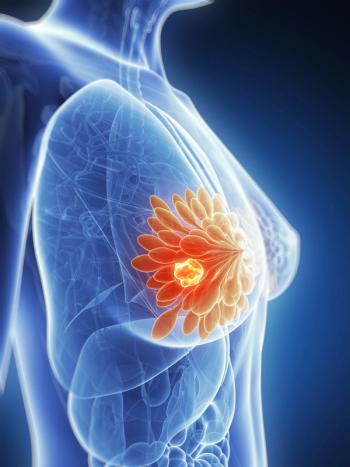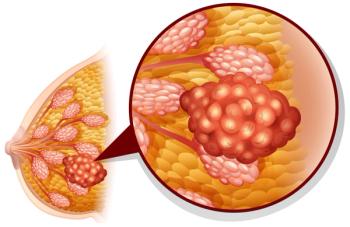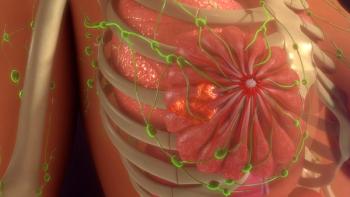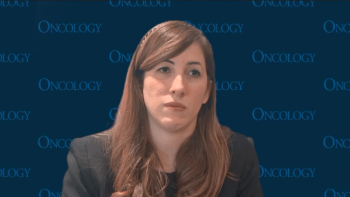
- ONCOLOGY Vol 12 No 1
- Volume 12
- Issue 1
Metastatic Breast Cancer: Experience with the Combination Paclitaxel Plus Epirubicin
This study evaluated the safety and feasibility of the combination of paclitaxel (Taxol) and epirubicin, the 4¢-epimer of doxorubicin, in women with metastatic breast cancer. A total of 85 patients with histologically proven
ABSTRACT: This study evaluated the safety and feasibility of the combination of paclitaxel (Taxol) and epirubicin, the 4¢-epimer of doxorubicin, in women with metastatic breast cancer. A total of 85 patients with histologically proven metastatic breast cancer were treated in two cohorts; epirubicin 60 mg/m² IV infused over 1 hour, followed by paclitaxel 175 mg/m² IV infused over 3 hours (group A), and epirubicin 90 mg/m² IV via a 1-hour infusion, followed by paclitaxel 175 mg/m² IV via a 3-hour infusion (group B). Of the 85 patients, 68 were evaluable for response and toxicity (43 in group A and 25 in group B). The combination was generally well tolerated. The higher epirubicin dose induced more severe neutropenia and one case of cardiotoxicity. Nonhematologic toxicities were mild, with no severe mucositis or peripheral neuropathy reported. Overall, 68% of patients in group A and 68% of patients in group B responded. A phase III trial comparing paclitaxel, 175 mg/m², plus epirubicin, 60 mg/m², with the standard combination of epirubicin, 60 mg/m², and cyclophosphamide (Cytoxan, Neosar), 600 mg/m², is currently in progress.ONCOLOGY 12(Suppl 1):36-39, 1998]
Paclitaxel (Taxol) is one of the few active drugs for the treatment of metastatic breast cancer. One of the most important observations made in the earliest studies of the drug by Holmes et al[1] and Reichman et al[2] was that clinical resistance to doxorubicin does not predict resistance to paclitaxel. This observation suggests the feasibility of evaluating the combination of paclitaxel and anthracyclines, which are also active in metastatic breast cancer.
Holmes et al[3] performed a phase I study in which paclitaxel was administered as a 24-hour intravenous infusion, followed by doxorubicin given as a 48-hour continuous infusion. The dose-limiting toxicity in this study was mucositis, which occurred with relatively low doses of both drugs. Sledge et al[4]described a phase I trial that used the same regimen but with the reverse sequence. The doxorubicin infusion was followed, after 4 hours, by a 24-hour paclitaxel infusion. The rate of severe mucositis associated with this schedule was very low. The maximum tolerated doses were 50 mg/m² of doxorubicin and 150 mg/m² of paclitaxel.
Dombernowski et al[5] and Gianni et al[6a] reported high response rates in patients with previously untreated metastatic breast cancer who received paclitaxel (via a 3-hour infusion) combined with doxorubicin. In these studies, the main toxicities were neutropenia and febrile neutropenia. Both studies described severe cardiac toxicities in 15% to 25% of patients. It was then showed that by limiting the cumulative dose of doxorubicin to 360 mg/m² or administering the two drugs with a more prolonged interval, the cardiac toxicity of the combination was limited to an incidence of 5%.[6b,6c]
Epirubicin, the 4¢-epimer of doxorubicin, is as effective as its parent compound but less cardiotoxic.[7] A literature search revealed eight trials in which doxorubicin and epirubicin were compared in patients with metastatic breast cancer. In three trials, identical doses of doxorubicin and epirubicin produced identical response rates.[8-10] In five others, the dose ratio of doxorubicin to epirubicin was 1.4.[11-15] The response rate was similar in all of these trials, independent of dose ratio. Mouridsen et al[16] reported that the two drugs have similar pharmacodynamics, antitumor spectrum, and levels of clinical efficacy.
The aim of this phase II study was to evaluate the safety and feasibility of combining paclitaxel and epirubicin in patients with metastatic breast cancer, focusing specifically on cardiac side effects.
Patients and Methods
Eligibility CriteriaOnly patients with histologically proven metastatic breast cancer were recruited to participate in this study. To be eligible, patients were not allowed to have received prior chemotherapy for metastatic disease, but they could have received one prior regimen of adjuvant chemotherapy or hormone therapy, or one palliative hormone therapy. If the patient had received prior anthracycline therapy, the total allowable dose was 300 mg/m².
Other eligibility criteria included measurable metastasis and normal hematologic, renal, and hepatic function, as well as age between 18 and 70 years and a life expectancy of more than 12 weeks. Patients who did not meet these criteria were not eligible for the study. Patients with congenital heart failure also could not participate.
Study DesignPatients were treated in two cohorts. Group A received epirubicin 60 mg/m² IV infused over 1 hour, followed by paclitaxel 175 mg/m² IV infused over 3 hours. Group B received epirubicin 90 mg/m² IV via a 1-hour infusion, followed by paclitaxel 175 mg/m² IV via a 3-hour infusion. Both groups were premedicated with dexamethasone 20 mg PO for two doses, one dose 12 hours and the other 6 hours before paclitaxel. In addition, patients received clemastine 2 mg IV, and ranitidine 50 mg IV, 30 minutes before paclitaxel.
Left-ventricular ejection fraction was assessed prior to treatment and after every second cycle by echocardiography or multiple-gated acquisition (MUGA) scanning.
Paclitaxel dose escalation (without granulocyte colony-stimulating factor support) was permissible to a dose of 225 mg/m², in 25-mg/m² steps, as long as the neutrophil count nadir was ³ 1 ´ 109/L and peripheral neuropathy was lower than World Health Organization (WHO) toxicity grade 2. In cases of higher toxicity grades, the paclitaxel dose could be reduced to 135 or 110 mg/m².
Initially, 57 patients were enrolled in group A and 28 patients were enrolled in group B. The median ages were 51 years (group A) and 55 years (group B), and the median Eastern Cooperative Oncology Group (ECOG) performance index was 0. Most of the women in the two groups (62% of group A and 76% of group B) were postmenopausal and most had poorly differentiated tumors (63% of group A and 74% of group B). Prior adjuvant chemotherapy had been administered to 51% of the patients in group A and 36% of those in group B.
Ultimately, 43 patients in group A and 25 in group B were evaluable for response and toxicity. In group A, 15 patients could not be evaluated for response; 12 of these patients had bone metastasis only and two had received prior chemotherapy for metastatic disease. In group B, three patients had bone metastasis with nonbone metastatic disease that was only evaluable but not measurable.
Nearly 20% of the patients had primary metastatic breast cancer with a large tumor at the primary site. Table 1 summarizes the location of metastases. More than 80% of the patients had two or more lesions (Table 2).
The main toxicity observed in both groups of patients was neutropenia, which reached WHO toxicity grade 3 or 4 during 73% of the courses in group A and 93% of the courses in group B. No episodes of febrile neutropenia developed in group A, and only two episodes occurred in group B. Thrombocytopenia and anemia were observed during fewer than 1% of the courses (Table 3).
Alopecia developed in all patients who completed two or more cycles of therapy. No peripheral neuropathy exceeded WHO grade 2, and grade 3 myalgia was reported in only 1% of the cycles. Severe nausea and emesis were observed in 2% of the cycles (Table 4), and no case of mucositis was described.
To date, no cardiac toxicity has been seen. Left-ventricular ejection fraction, assessed by echocardiography or cardiac scintigraphy, did not change in any patient in group A. One patient in group B showed a significant decrease (> 10%) in ejection fraction that was not accompanied by clinical signs.
Dose Modification
In group A, 15 patients were able to tolerate escalation of the paclitaxel dose to 200 mg/m², and further escalation to 225 mg/m² was possible in seven of these patients. In group B, dose escalation to 200 mg/m² was possible in only one patient, and no patient could tolerate 225 mg/m². On the other hand, severe neutropenia necessitated a dose reduction to 135 mg/m² in 11 group-A patients and a subsequent reduction to 110 mg/m2 in four of these patients. Dose reduction to 135 mg/m² was required in three group-B patients.
Response
Response was not the main end point of this study, but it is a principal concern of oncology treatment. Results achieved in this poor-prognosis population are shown in Table 5. Overall response was similar in the two groups. Escalation of paclitaxel dose was not associated with higher remission rates. Similarly, paclitaxel dose reduction due to neutropenia had no apparent effect on remission rates (Table 6). In 50% of patients who responded, remission was achieved after the second course of treatment; 25% of patients had their best result after the fourth course; and the remaining 25% of responses were seen after the sixth course.
The median follow-up time was 14.1 months in group A and 8.2 months in group B. The median progression-free interval was 8.2 months in both groups, with a range of 5.3 to 11.3 months in group A and 7.9 to 8.5 months in group B. When broken down according to response, the median progression-free interval was 12.5 months (95% confidence interval [CI], 9.7 to 15.3 months) in group A patients who attained a complete response and 8.1 months (95% CI, 6.7 to 10.3 months) in those who had a partial response. In group B, the median progression-free interval for patients with a partial response was 8.2 months (95% CI, 7.8 to 8.5 months).
The median overall survival from study entry was 15.9 months (95% CI, 12.8 to 19 months) in group A. In group B the median survival has not been reached.
In this study, the combination of paclitaxel 175 mg/m² and epirubicin 60 or 90 mg/m² showed remarkable efficacy against metastatic breast cancer. The overall response rates were 68% in group A (treated with 60 mg/m² of epirubicin) and 68% in group B (given 90 mg/m² of epirubicin).
The combination of paclitaxel and epirubicin was generally well tolerated. The higher epirubicin dose induced more severe neutropenia and one case of cardiotoxicity. Nonhematologic toxicities were mild, and no cases of severe mucositis or peripheral neuropathy were reported.
Neither the higher epirubicin dose nor the modified paclitaxel doses altered progression-free survival. The remission rates observed in the present study were lower than those reported in the study by Gianni et al[6] in patients with no prior treatment except surgery. However, the progression-free interval was in the same range as that observed by Gianni et al.
Based on the results of this study, in December 1996 the German AGO (Arbeitsgemeinschaft Gynäkologische Onkologie) Breast Cancer Study Group initiated a phase III trial comparing the combination of paclitaxel 175 mg/m² and epirubicin 60 mg/m² with the standard combination of epirubicin 60 mg/m² and cyclophosphamide (Cytoxan, Neosar) 600 mg/m² as first-line treatment of metastatic breast cancer. At the time of publication, more than 230 patients have been recruited.
References:
1. Holmes FA, Walters RS, Theriault RC, et al: Phase II trial of Taxol, an active drug in the treatment of metastatic breast cancer. J Natl Cancer Inst 83:1797-1805, 1991.
2. Reichman BS, Seidman AD, et al: Paclitaxel and recombinant granulocyte-stimulating factor as initial chemotherapy for metastatic breast cancer. Semin Oncol 11:1943-1951, 1993.
3. Holmes FA, Frye D, et al: Phase I study of Taxol and doxorubicin for metastatic breast cancer. Proc Am Soc Clin Oncol 11:60, 1992.
4. Sledge GW Jr, Robert N, et al: Paclitaxel (Taxol)/doxorubicin combinations in advanced breast cancer: The Eastern Cooperative Oncology Group experience. Semin Oncol 21:15-18, 1994.
5. Dombernowski P, Gehl J, Ejlersen B, et al: Treatment of metastatic breast cancer with paclitaxel and doxorubicin. Emerging Strategies in Medical Oncology 3-4, 1994.
6a. Gianni L, Munzone E, Capri G, et al: Paclitaxel by 3-hour infusion in combination with bolus doxorubicin in women with untreated metastatic breast cancer: High antitumor efficacy and cardiac effects in a dose finding and sequence finding study. J Clin Oncol 13:2688-2699, 1995.
6b. Gianni L, Capri G, Tarenzi E, et al: Efficacy and cardiac effects of 3-h paclitaxel plus bolus doxorubicin in women with untreated metastatic breast cancer (abstract 128). Proc Am Soc Clin Oncol 15:116, 1996.
6c. Moliterni A, Tarenzi E, Capri G, et al: Pilot study of primary CT with doxorubicin plus paclitaxel in women with locally advanced breast cancer or operable breast cancer. Semin Oncol 24(suppl 17):10-14, 1997.
7. Praga C, Trave F, Petroccion A: Anthracycline-induced cardiotoxicity and its relevance in cancer treatment. Clinical Measurements in Drug Evaluation 131-142, 1991.
8. Brambilla C, Ross A, Bonfonte V, et al: Phase II study of doxorubicin vs epirubicin in advanced breast cancer. Cancer Treat Rep 70:261-266, 1986.
9. Lawton PA, Ostrowski M, Young T: Efficacy and toxicity of single-agent chemotherapy in advanced breast cancer. Br J Cancer 61:177, 1990.
10. Pervodchikova NI, Valvore VJ: Comparative evaluation of farmorubicin and Adriamycin in breast cancer. Progress in Antimicrobial and Anticancer Chemotherapy 3:474-477, 1997.
11. Hortobagyi GN: A comparative study of doxorubicin and epirubicin in patients with metastatic breast cancer. Am J Clin Oncol 12:57-62, 1989.
12. Jain K, Casper ES, Geller NL, et al: A prospective randomized comparison of epirubicin and doxorubicin in patients with advanced breast cancer. J Clin Oncol 3:818-826, 1985.
13. Taguchi T, Ogawa M, Izuo M, et al: A prospective randomized trial comparing epirubicin and doxorubicin in advanced breast cancer. J Cancer Chemother 13:3498-3507, 1986.
14. Van Oosterom AT, Andersson M, et al: Adriamycin (A) versus 4-epi-adriamycin (E). Report of a second-line randomised phase III study in advanced breast cancer (trial 10811). Proceedings of the IV EORTC Breast Cancer Working Conference 1.6:1987.
15. Perez DJ, Harvey VJ, Robinson BA, et al: A randomized comparison of single-agent doxorubicin and epirubicin as first-line cytotoxic therapy in advanced breast cancer. J Clin Oncol 9:2148-2152, 1991.
16. Mouridsen HT, Alfan C, et al: Current status of epirubicin (farmorubicin) in the treatment of solid tumors. Acta Oncol 29:257-285, 1990.
Articles in this issue
almost 28 years ago
Small-Cell Lung Cancer: Is There a Standard Therapy?almost 28 years ago
Recent Advances With Chemotherapy for NSCLC: The ECOG Experiencealmost 28 years ago
Overcoming Drug Resistance in Lung Canceralmost 28 years ago
Paclitaxel/Carboplatin in the Treatment of Non-Small-Cell Lung Canceralmost 28 years ago
The Role of Carboplatin in the Treatment of Small-Cell Lung Canceralmost 28 years ago
Future Directions in Non-Small-Cell Lung Cancer: A Continuing PerspectiveNewsletter
Stay up to date on recent advances in the multidisciplinary approach to cancer.





















































































